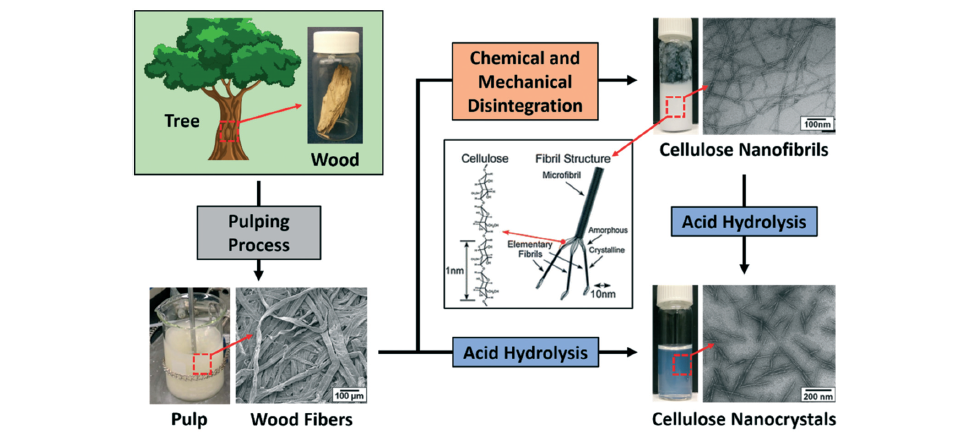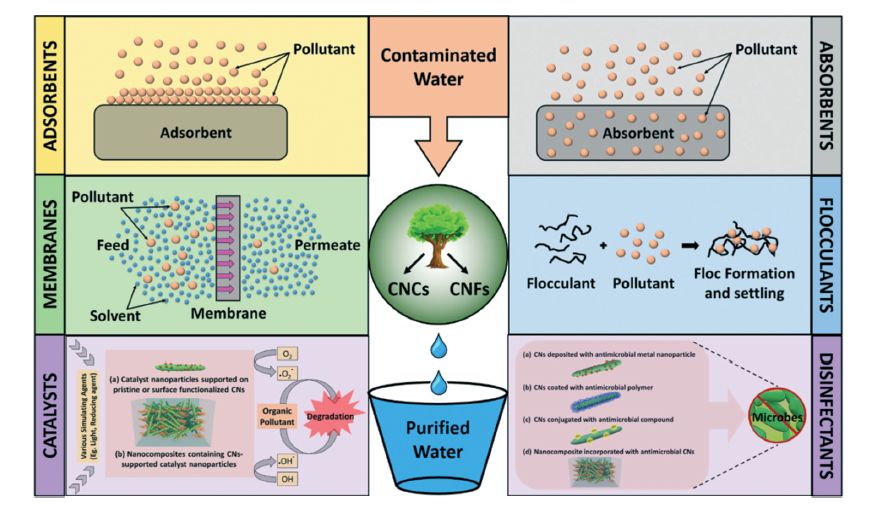As water quality diminishes across the globe, removing pollutants from our water systems is of prime importance. Conventional water and wastewater treatment processes, no matter how efficient, have a large carbon footprint. In recent years, sustainable nanomaterials, such as those derived from cellulose – the most abundant biopolymer on the planet – have been widely explored. The unique properties of cellulose nanomaterials (CNs), coupled with the global quest for low-carbon-footprint treatment alternatives, has spurred a growing interest among researchers worldwide. The chemistry and modification of CNs is well-documented, however, few have explored their potential in water and wastewater treatment applications.
Methodology
The Tam Group at the University of Waterloo was invited to contribute a review article on the development and use of sustainable nanomaterials for water and wastewater treatment systems. A summary on the state of the technology and the research activities of the Tam’s group at the University of Waterloo is documented below.
Cellulose nanomaterials were recently classified into two groups: cellulose nanocrystals (CNCs) and cellulose nanofibrils (CNFs). They are derived from various cellulosic sources, such as wood, plants, tunicates, algae, and bacteria, but differ in the way they are produced. In this review, we focus exclusively on the use of CNs extracted from plant-based sources owing to their large-scale availability for their application in water treatment processes. Fig. 1 shows the process of extracting CNs from trees.

Figure 1: Extraction of cellulose nanomaterials from plant sources (sections of this schematic diagram are reproduced with permission from ref. 8, 9 and 10 in Environmental Science: Nano (2018), 5, 623-658)
Outcomes
This review provides a detailed summary of pristine, surface functionalized CNs and CN-incorporated nanocomposites that have been developed for various water and wastewater treatment processes, such as sorption, flocculation, membrane filtration, catalytic degradation, and disinfection. Fig. 2 illustrates the water and wastewater treatment processes where CNs can be utilized.

Figure 2: Water and wastewater treatment processes containing CN-based systems (Environmental Science: Nano (2018), 5, 623-658).
CNs possess many desirable properties over conventional materials, such as activated carbon and petroleum-based polymers used in water treatment systems: for water and wastewater treatment systems:
- Unlike activated carbon, they do not require high temperatures to produce, thus they have a comparatively lower carbon footprint.
- They are more sustainable and environmentally friendly compared to their petroleum-based counterparts.
- The increased surface-area-to-volume ratio and quantum size effects produced from cellulosic sources not only increase the amount of adsorption sites, but also offer the possibility of tuning the surface properties of CNs through chemical modification. This makes CNs ideal for surface functionalization compared to native cellulose, thereby creating active sites for adsorption.
- They possess good mechanical strength and dispersibility in water, making them ideal for use in filtration membranes and as flocculants, respectively.
The desirable properties of CNs open the door for their use in various water treatment applications. Adsorbents based on CNs are ideal for removing dyes, heavy metal ions, pharmaceuticals and several other contaminants in wastewater. Initial studies using CN-based absorbents have shown promising results for oil and water separation. The functionalization strategies employed in the majority of these studies involved an expensive silanization procedure, which would pose a challenge for large-scale application. Membranes based on CNF nanopapers and CN-reinforced polymeric composites displayed better performance in the filtration of a wide variety of contaminants. However, extensive studies on membrane fouling are lacking. This omission must be addressed as cellulosic sources can act as food sources for microorganisms that can grow on these membranes. Flocculants based on CNs are found to be effective in flocculating dyes, heavy metal ions, clay particles and bacterial biomass.
In addition, CN-based flocculants are a good alternative to commercial synthetic polymers that lack biodegradability. Nevertheless, systematic dewatering studies that examine their ability to produce solid sludge for biogas production or landfill are needed before they can be used in practical water treatment operations. Catalysts and disinfectants supported by CNs are emerging functional nanomaterials that may find new applications in wastewater treatments. The majority of the studies only concentrated on material synthesis and evaluating the catalytic or antibacterial performance using model systems. The practical applicability of CNs in catalytic degradation and disinfection-based water treatment processes needs to be further investigated.
Conclusions
Owing to the high surface area and high colloidal stability of CNs, we believe that CNs are excellent candidates for large-scale catalytic or disinfection-based water treatment operations. Resource recovery is important and this can be resolved via functional modification of the systems with magnetic nanoparticles that can be easily separated using a magnetic field. Thus, CNs offer many possibilities for water remediation in industries, such as textile, pulp and paper, leather tanning, metal plating, mining, paint, fertilizer, food and pharmaceuticals.
Although they have enormous potential, future research and development should focus on reducing production costs and tailoring CNs surface functionalities for deployment in water and wastewater treatment. We also need to exploit novel intelligent CN-based nanohybrids by functionalizing them with responsive moieties, which can be tailored to specific applications, such as selective adsorption, simultaneous sensing and scavenging, etc. Current research almost exclusively focuses on the development of functional nanomaterials, and not on their scalability in water treatment processes. This is something that materials scientists, chemists and chemical engineers need to collaborate on. Work in this area is fast-paced, and thus we foresee sustainable nanomaterials being actively used to treat water and wastewater in the near future as a viable alternative to conventional treatment processes.
Mohammed, N., Grishkewich, N., & Tam, K.C. (2018). Cellulose nanomaterials: promising sustainable nanomaterials for application in water/wastewater treatment processes. Environmental Science: Nano, 5(3), 623-658.
Contacts: Nathan Grishkewich, Department of Chemical Engineering; Nishil Mohammed, Department of Chemical Engineering; Michael Tam, Department of Chemical Engineering.
For more information about WaterResearch, contact Amy Geddes.






